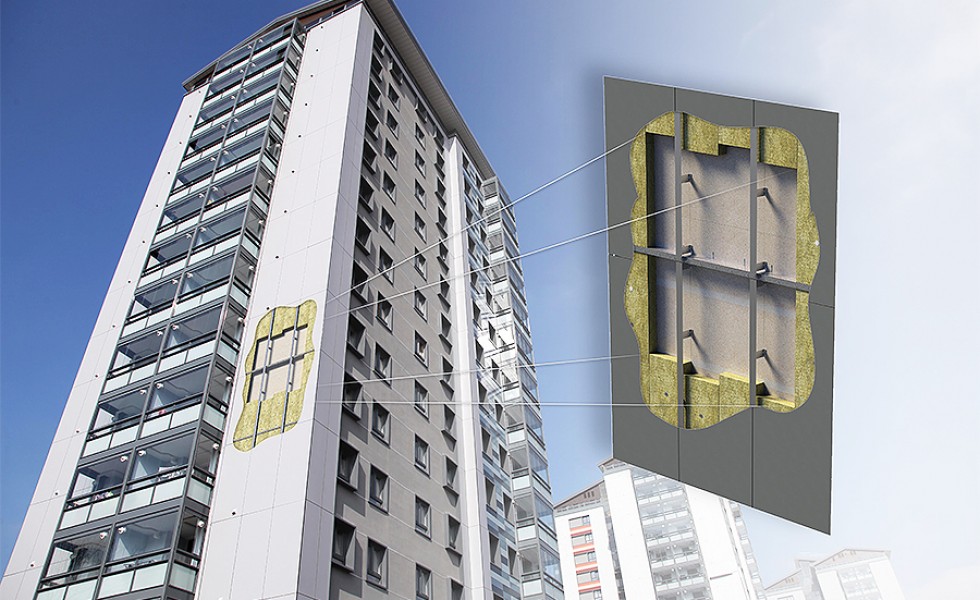Recladding – Giving Our Buildings a New Lease of Life
19/5/23
Lisa Stephens, Building Envelope Product Manager at ROCKWOOL UK, explains the benefits of recladding and which factors need to be considered when planning a new recladding project.
In recent years, regulations governing the cladding of buildings, especially high-rise buildings, have been scrutinised and strengthened. While the main function of the facade system, including the cladding, has always been to protect the building and its residents from external environmental influences, other advantages of installing high-quality cladding have also become important, such as acoustic protection and fire safety.
Safety first
The ban on combustible materials in the external walls of relevant buildings over 18m, which came into force in 2018, requires building materials to achieve a minimum class of A2-s1,d0 in the Euroclass fire performance rating. In England, ADB also provides guidance on the use of combustible materials in residential buildings over 11m. In Scotland, the ban applies to buildings over 11m.
As a result, many building owners are recladding existing buildings with non-combustible materials to either meet new regulatory requirements or provide greater safeguarding to users.
Facade systems are constructed with external cladding, insulation and an air gap, which are attached to the structural frame to create a through-wall build up. The insulation layer provides a barrier against adverse environmental conditions, mainly heat and noise. To ensure all elements of the building envelope are non-combustible, only insulation materials that achieve the required Euroclass fire performance rating can be used in the facade system.
Non-combustible by nature
Stone wool is naturally non-combustible, which means it will not contribute to fire spread, nor will it emit significant toxic smoke if exposed to flames. There are stone-wool insulation products that have been specifically developed for use within ventilated cladding systems, as well as sealed systems such as curtain walling. Some of these stone-wool insulation solutions are manufactured using Dual Density technology. With these, the outer surface of each insulation slab features a distinctly higher density than the underside. This provides a firm and robust surface for the application of fixings, while the underside can accommodate unevenness in the substrate. Once installed, the higher-density outer surface works in combination with a factory-applied water-repelling agent to give improved resistance to rain ingress during construction.
Creating a comfortable environment
The main function of insulation in buildings is temperature control. It is vital to keep the indoor climate comfortable and healthy, which means effective temperature regulation as opposed to simply keeping the heat in. With the recent climate changes, hotter summers mean that insulation is also needed to keep the heat out.
Without appropriate insulation, the increased demand to heat or cool buildings raises energy consumption, associated costs and CO2 emissions. Around 20% of greenhouse gas emissions in the UK are caused by heating buildings. The EU has calculated that proper insulation can reduce a building's heating needs by up to 70%.
Noise is another environmental factor that can be managed with the right insulation. While it is highly subjective as to which sounds are considered noise and which are deemed bearable, insulation helps to regulate building acoustics to the required levels.
Stone wool is very effective in acoustic protection because the fibres in stone wool are randomly orientated. As sound waves try to pass through the air trapped within the fibrous structure, they get absorbed by friction as the individual fibres are made to move back and forth. In addition, the random orientation of the fibres gives rise to high tortuosity, which makes it very difficult for sound to find a path from one side to the other. To provide greater support with specifying stone-wool insulation for sound control, ROCKWOOL rainscreen products have been independently acoustically tested and shown to reduce the transfer of external noise into buildings.
Improved looks
In addition to the improved thermal and acoustic performance that new cladding can provide, it also gives the building a facelift. With the modern building materials available, architects and designers can create innovative new designs and rejuvenate sometimes tired-looking older buildings. A new-look exterior can also help to regenerate the area and make the buildings stand out.
Looking forward
Since the Grenfell disaster, potentially dangerous cladding has become a complication for buyers who are looking to secure a mortgage for a flat in a cladded building. New guidance by the Royal Institution of Chartered Surveyors (RICS) has led six of the biggest UK banks to review their policies. The banks will offer mortgages on properties in buildings above 11m where there are safety issues, but an agreed remediation plan funded by either the Government or a developer has to be in place.
Following this development, recladding could secure the future of many high-rise buildings in the UK for years to come.
Source; Future Constructor and Architect

